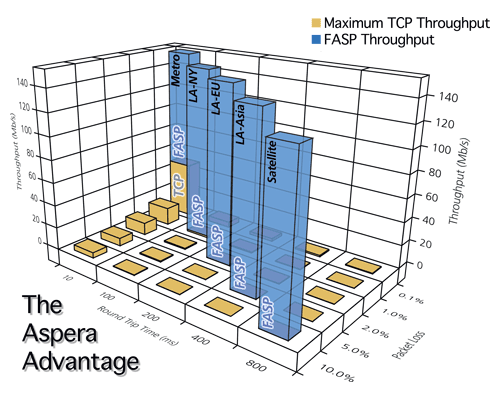10Gb/s transfer speeds (in and out of the cloud) now possible
The key to seamless cloud computing is the fast and reliable transfer of files in and out of the remote environment in which they are stored. The faster the transfer, the more productive and profitable a broadcaster can be. At the recent BioIT World 2013 conference in Boston, Aspera, a provider of file transfer software, said that, working with Intel Corp., it was able to send files at 10Gb/s speeds (called “fasp transfers”) using its software running on an Intel Xeon processor E5-2600 workstation in a virtualized (cloud) computing environment.
The companies said initial benchmark tests compared the performance of Aspera transfers on a high-performance Intel system versus a similar system that did not support Intel’s Data Direct I/O Technology. Additional tests focused on data transfer over a 10GigE connection between high-end Intel systems with built-in support for Single-Root I/O Virtualization (SR-IOV), as well as over a WAN connection with varying degrees of latency (50ms to 500ms) and packet loss (0.1 percent to 5 percent).

The results were published in a joint Aspera/Intel whitepaper that illustrates how Intel’s DDIO technology allows Ethernet controllers to route I/O traffic directly to the processor cache and, with built-in support for SR-IOV technology, achieve approximately the same throughput in both virtualized and physical computing environments. This includes a 300-percent throughput improvement versus a baseline system that did not contain support for DDIO and SR-IOV (showing the advantages of Intel’s Xeon processor E5-2600 product family),
The research also found similar results across both LAN and WAN transfers, confirming that Aspera fasp transfer performance is independent of network latency and reduces packet loss on the network.
One of the major challenges in high-performance cloud computing is the capability of moving big data in and out of the backend data center, especially across increasingly virtualized environments. Today, high-performance servers and hardware are already deployable inside the data center, and WAN bandwidth can be provisioned beyond multi-Gbps. Unfortunately, the report states, existing transport technology lacks the capability of fully using the end-to-end capacity provided by underlying hardware platform, particularly over the wide area and traditional host system architectures limit per-packet processing to sub 10Gb/s speeds. Intel and Aspera said they are collaborating to address and eliminate both bottlenecks.
Aspera’s fasp transport technology was created to overcome the bottlenecks of traditional transport protocols in moving large data over the wide area network. Aspera fasp has no theoretical throughput limit, and is practically constrained by the available network bandwidth and the hardware resources at both ends of the transfers.
Intel’s DDIO and Non-Uniform Memory Access (NUMA) technologies were designed to deliver superior I/O throughput, and SR-IOV allows virtual machine platforms to bypass the hypervisor in order to directly access resources on the physical network interface for superior I/O performance particularly important for high-throughput large data transfer.
The professional video industry's #1 source for news, trends and product and tech information. Sign up below.
